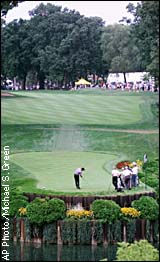|
|

| ||||||||||||
| ALSO SEE ESPN Golf Online's PGA Championship coverage
| ||||
| SPORTS NBA | ||||
|
Friday, Sep. 17 5:21pm ET Medinah has 7,401 reasons to be tough By Bob Harig Special to ESPN Golf Online | |
MEDINAH, Ill. -- They peer around doglegs, looking for gremlins in the grass. They approach water hazards, sticking in only their toes. They arrive at Medinah Country Club, expecting trouble. Who would blame them?
 | |
| The finishing hole at Medinah is a challenging 445-yard par-4. |
What's next? Simply the longest course in major championship history, a 7,401-yard brute that is some 300 yards longer than when Medinah No. 3 was the site for the 1990 U.S. Open.
"I dare say, this might be the longest course I've played, ever," said Greg Norman. "I look forward to seeing how they play it. I just don't want to see figures like 6-, 7-, 8-over par becoming a norm for winning a major championship."
It sure appears headed in that direction. The recent trend has been to make the major championship courses as difficult as possible, to ensure that the vaunted venues produce red faces rather than red numbers.
Just this year, we've seen only one player able to break par at the U.S. Open and a winning score of 6-over at the British Open. In 1959, 1963 and 1972, the aggregate scores of the major winners was 5-under, the highest on record. This year's aggregate is 3-under.
"Carnoustie was obviously the most difficult British Open course we played," said eight-time major championship winner Tom Watson. "The Masters, the scores were not very low. I thought the U.S. Open was set up fairly, the way it should be played. With Carnoustie in there to really skew the difficulty, these are probably the four most difficult (major) courses we play."
Don't expect any easy test for the players at Medinah, either. The site of Hale Irwin's third U.S. Open title in 1990, two green renovation projects have been completed since then. The second and 13th greens were rebuilt in 1991, followed by the rebuilding of the first, 16th and 17th greens in 1996.
The course has also been lengthened to 7,401 yards, making it the longest in major championship history at sea level.
It seems that Irwin's winning score of 8-under -- tied with Mike Donald -- rankled a few of the folks at Medinah.
"When the U.S. Open was here in 1990, the USGA came in and mowed the rough to 5 inches the day before the tournament," said Keith Peterson, the superintendent for Medinah No. 3. "Then the rain came in that night. That mistake won't happen again. That's what we told the PGA."
This time, the rough was cut to 5 inches on Monday, then left to Mother Nature. If it grows taller during the week, so be it.
"That course (in 1990) was compromised by the USGA," said Dan Quast, Medinah's grounds manager. "They set up the course so easy. I don't think that's going to happen again. ... There's no tricks here, and I think the players will say it was very fair. But I'm not concerned about comments from players."
Detect any bitterness? No question, Medinah is a proud club, having hosted three U.S. Opens (1949, 1975, 1990), three Western Opens (1939, 1962, 1966) and a U.S. Senior Open (1988). Abe Espinosa, Tommy Armour and Ralph Guldahl were among the club's early professionals.
But few remember that Irwin and Donald finished 8-under. What they remember is Irwin's improbable birdie putt on the 72nd hole, his romp around the green, his emotion. They remember the playoff with journeyman Donald, whose life would have changed considerably if he had won. They are not so concerned about how those players got there.
Yet when is it too much? Irwin forged a reputation for winning on some stern layouts, but even he was startled to learn about the length of Medinah.
"You've got to be kidding me," Irwin said when hearing about the 7,401 yards for the first time. "When you can't see the green from the tee, you know that's a real stretch."
The rating for the par-72 course is 77.1, with a slope of 149. Only the 1967 PGA Championship at Columbine Country Club in the thin air of Littleton, Colo., was longer at 7,436 yards. With 4- to 5-inch rough and more than 4,200 trees, the fairways will look like walking paths.
"I don't think it's bad to lengthen a course a little," said Justin Leonard. "With 7,400 yards, you're certainly seeing an extreme. I would like to see more creative ways to make a course more difficult. Do it more strategically, with a bunker here and there, and the greens, instead of just adding 40 yards. Some of the hardest holes we play are short, with two precise shots needed."
Bob Harig, who covers golf for the St. Petersburg Times, writes a column every Tuesday for ESPN Golf Online.
| ESPN INSIDER | COMMUNITY | MY INSIDER | BACKSTAGE
Copyright 1995-99 ESPN/Starwave Partners d/b/a ESPN Internet Ventures. All rights reserved. Do not duplicate or redistribute in any form.ESPN.com Privacy Policy (Updated 12/21/98). Use of this site signifies your agreement to the Terms of Service (Updated 01/12/98). | ||||